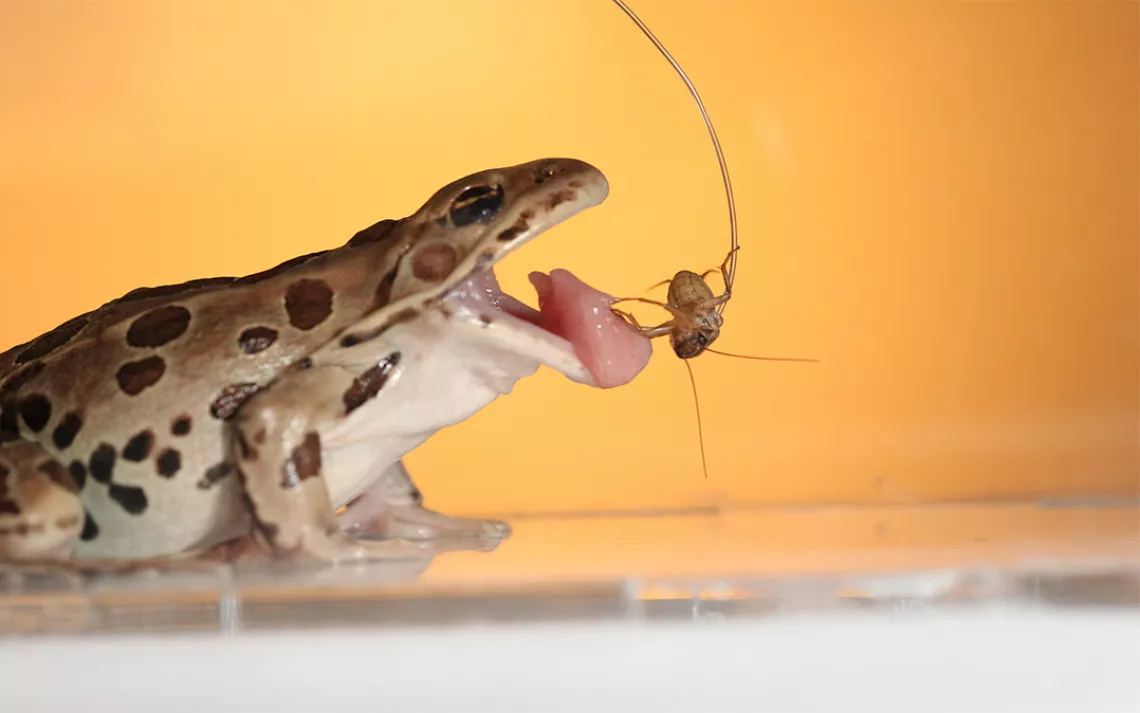Frogs Can Deliver a Real Tongue Lashing
A team of researchers set out to understand why frog tongues are so sticky

Photo by Candler Hobbs
Anyone who’s tried to use a piece of tape that’s gotten wet or dirty knows that it loses its stickiness pretty fast. So when Georgia Tech PhD candidate Alexis Noel and her advisor, biolocomotion researcher David Hu, saw a YouTube video of a Pac-Man frog expertly “catching” digital ants crawling down a cellphone screen, it got them wondering: How exactly does a frog do it?
All of the 4,700 frog species in the world use their sticky tongues to catch prey, flicking it out at speeds faster than a human can blink. The tongue is so adhesive that it can easily turn dusty crickets, slippery worms, hairy spiders, and anything else that comes into range into a tasty snack. But exactly how has been a mystery. “Previous research on frog tongues was pretty slim,” says Noel. “There has been research on frog tongue musculature, the surface structure, epithelial tissue, and neurological pathways, but no one had looked at the adhesive properties of the saliva to answer why it is so sticky.”
In 2014, German researchers unraveled some of the mystery when they discovered that the tongue of one horned frog species had an adhesion force 1.4 times its own body weight. Those researchers also found that the frog’s saliva acts more or less like a piece of sticky tape.
Noel and Hu wanted to dig deeper into the mechanics of that stickiness. They began their work by filming six species of frog from the Atlanta-based Amphibian Foundation with high-speed cameras. Those videos showed them just what the tongues could do—they were able to snatch an insect in just 0.07 seconds and retract it into their mouth at 12 times the force of gravity.
The team then collected northern leopard frog tongues used in a biology dissection class from the Georgia Tech campus. Examining the tongues, they found that the material was extremely soft, supple, and stretchy, about 10 times softer than the human tongue and roughly as soft as brain tissue. The next step was gathering frog saliva to test its properties. Which is harder than it sounds. Unlike humans, who drip saliva from glands in the mouth onto the tongue, Noel explains that frog tongues produce their own saliva and are similar to sponges infused with fluid. So the team had to spend an evening pulling out the tongues of 18 frogs and wiping them with plastic sheets until they collected enough globules of the snotlike saliva for study.
Analysis of the frog spit showed something interesting. The saliva is a two-stage viscoelastic fluid, a type known as a non-Newtonian. In English, that means when the frog’s tongue lashes out and hits, say, a grasshopper, the force of the impact turns the saliva into a thin liquid. The super-soft tongue and the juicy saliva can wrap around the insect and penetrate all the gaps and nooks in its body in a split second, getting a firm grasp. When the frog yanks its tongue back toward its mouth, however, the saliva thickens up even more than honey, making it super sticky. Once the six-legged snack is in its mouth, the frog blinks, using its eyeballs to once again loosen the saliva and scrape the insect off its tongue and down the hatch. The research appears in the Journal of the Royal Society Interface.
“We weren’t surprised that the saliva was a non-Newtonian fluid, but we were surprised by the shear thinning,” says Noel, explaining that shear thinning is when the viscosity, or thickness of a fluid, decreases under stress. The same principle applies to other common fluids like ketchup and house paint. With paint, for instance, pressure from the brush makes it liquid and spreadable, but once the brush is removed the paint thickens and sticks to the wall. That principle is even more noticeable in the frog saliva. “There’s a stark difference between the two phases. It’s very rapid, and there’s a very fast drop in viscosity when the frog retracts its tongue.”
In fact, the combo of the tongue and the saliva creates an adhesive force about 50 times stronger than some synthetic adhesive polymers. Hu says that most adhesives in production today are fairly stiff, like tape. But the new research could lead to soft sticky adhesives used in things like Band-Aids, manufacturing soft robots, or even new ways for drones to pick up objects.
Christopher Raxworthy, a curator at the American Museum of Natural History who has found many new species of reptiles and amphibians in the field, says this research is exciting for herpetologists. “Work like this is so cool when you read about it and begin to understand the mechanisms in these animals,” he says. “This is something that happens in an instant, and in the field it is not something that’s easy to see. It always strikes me how important it is to look at these species in the laboratory under controlled conditions.”
Noel says she plans to eventually start looking into ways to create new adhesives based on frog tongues, and also hopes to look at similar properties in chameleon tongues (and especially how they lick their eyeballs without hurting themselves). But she says that working on frogs in the lab emphasizes just how important their conservation is outside the lab, since they still have plenty to teach us.
 The Magazine of The Sierra Club
The Magazine of The Sierra Club







